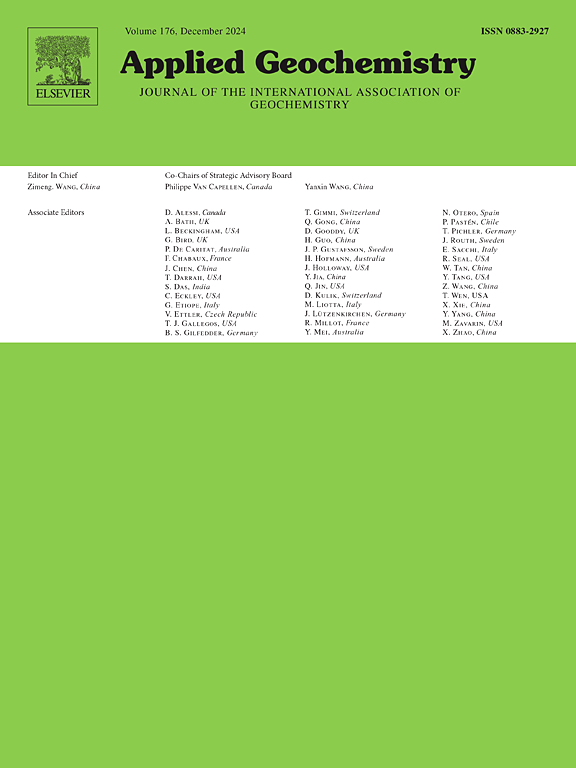Fluid-rock reaction path modeling of uranium mobility in granite-related mineralization: A case study from the Variscan South Armorican Domain
IF 3.1
3区 地球科学
Q1 GEOCHEMISTRY & GEOPHYSICS
引用次数: 0
Abstract
The mobilization of uranium in granite-related systems presents a complex interplay of chemical and hydrodynamic factors. This is particularly obvious within syn-orogenic detachment zones where per descensum surface-derived fluids interact with per ascensum deeply sourced hydrothermal fluids. In this study, we employ a thermo-hydro-chemical (TH-C) modeling approach to explore the multifaceted processes that govern uranium transport and deposition in such environments. Our findings indicate that uranium mobility is not solely determined by the oxidizing nature of the percolating surface-derived fluids. Actually, the oxidation-reduction potential of these fluids varies as they flow in the crust, ultimately adjusting towards more neutral or mildly reducing conditions conducive to uranium dissolution and precipitation. Even in the presence of magnetite, which enhances the reductive potential of the fluids, uranium continues to dissolve, albeit in much smaller quantities, with U(IV) being the predominant species in the aqueous phase. The study highlights the crucial roles of temperature, pH, and fluid/rock interaction ratios in influencing uranium leaching efficacy. High fluid/rock ratios enhance uranium extraction from source rocks. A fluid/rock ratio around 1 is optimal, maximizing the dissolution of uranium-bearing minerals in the source rock and promoting the precipitation of uranium minerals in different locations along the fluid pathway due to changes in fluid chemistry. The TH-C modeling has the potential to be applied to a variety of other uranium deposits, developed below 300 °C.
花岗岩相关成矿作用中铀流动的流-岩反应路径模拟:以Variscan南美洲域为例
铀在花岗岩相关系统中的动员是化学和水动力因素的复杂相互作用。这一点在同造山拆离带内尤为明显,在同造山拆离带内,各下沉面源流体与各上升深源热液流体相互作用。在这项研究中,我们采用热-水化学(TH-C)建模方法来探索在这种环境中控制铀运输和沉积的多方面过程。我们的研究结果表明,铀的流动性不仅仅取决于渗透表面衍生流体的氧化性质。实际上,这些流体的氧化还原电位随着它们在地壳中的流动而变化,最终调整到更中性或更温和的还原条件,有利于铀的溶解和沉淀。即使在磁铁矿存在的情况下(磁铁矿增强了流体的还原潜力),铀继续溶解,尽管数量要少得多,而铀(IV)是水相中的主要物质。该研究强调了温度、pH和流体/岩石相互作用比在影响铀浸出效果中的关键作用。高流体/岩石比提高了从烃源岩中提取铀的能力。流体/岩石比值为1左右为最佳,可使含铀矿物在烃源岩中溶蚀作用最大化,且由于流体化学的变化,可促进铀矿物沿流体路径在不同位置的沉淀。TH-C模型有可能应用于300°C以下开发的各种其他铀矿床。
本文章由计算机程序翻译,如有差异,请以英文原文为准。
求助全文
约1分钟内获得全文
求助全文
来源期刊

Applied Geochemistry
地学-地球化学与地球物理
CiteScore
6.10
自引率
8.80%
发文量
272
审稿时长
65 days
期刊介绍:
Applied Geochemistry is an international journal devoted to publication of original research papers, rapid research communications and selected review papers in geochemistry and urban geochemistry which have some practical application to an aspect of human endeavour, such as the preservation of the environment, health, waste disposal and the search for resources. Papers on applications of inorganic, organic and isotope geochemistry and geochemical processes are therefore welcome provided they meet the main criterion. Spatial and temporal monitoring case studies are only of interest to our international readership if they present new ideas of broad application.
Topics covered include: (1) Environmental geochemistry (including natural and anthropogenic aspects, and protection and remediation strategies); (2) Hydrogeochemistry (surface and groundwater); (3) Medical (urban) geochemistry; (4) The search for energy resources (in particular unconventional oil and gas or emerging metal resources); (5) Energy exploitation (in particular geothermal energy and CCS); (6) Upgrading of energy and mineral resources where there is a direct geochemical application; and (7) Waste disposal, including nuclear waste disposal.
 求助内容:
求助内容: 应助结果提醒方式:
应助结果提醒方式:


